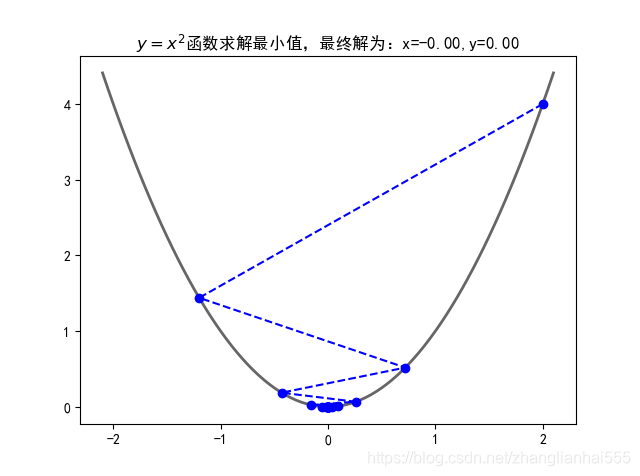上篇博客说的是梯度下降法,主要讲的原理及公式推导,这篇博客来进行代码实现。包括手动模拟梯度下降的方式来进行求解,以及运用自己实现的梯度下降来完成一个线性回归的例子。
模拟梯度下降 求解
这里手动模拟梯度下降的方式来进行求解,首先来一个一维的,以 为例:
import numpy as np
import matplotlib.pyplot as plt
## 设置字符集,防止中文乱码
plt.rcParams['font.sans-serif']=[u'simHei']
plt.rcParams['axes.unicode_minus']=False
# # 原函数
def f(x):
return x ** 2
# # 导数
def h(x):
return 2 * x
X = []
Y = []
x = 2
step = 0.8
f_change = f(x)
f_current = f(x)
X.append(x)
Y.append(f_current)
while f_change > 1e-10:
x = x - step * h(x)
tmp = f(x)
f_change = np.abs(f_current - tmp)
f_current = tmp
X.append(x)
Y.append(f_current)
print('最终结果为:', (x, f_current))
fig = plt.figure()
X2 = np.arange(-2.1, 2.15, 0.05)
Y2 = X2 ** 2
plt.rcParams['font.sans-serif'] = ['SimHei'] # # 中文宋体
plt.plot(X2, Y2, '-', color='#666666', linewidth=2)
plt.plot(X, Y, 'bo--')
plt.title('$y=x^2$函数求解最小值,最终解为:x=%.2f,y=%.2f' % (x, f_current))
plt.show()
最终结果为: (-5.686057605985963e-06, 3.233125109859082e-11)
运行的效果图:

再来一个二维的,以 为例:
import numpy as np
import matplotlib.pyplot as plt
from mpl_toolkits.mplot3d.axes3d import Axes3D
# # 原函数
def f(x, y):
return x ** 2 + y ** 2
# # 偏函数
def h(t):
return 2 * t
X = []
Y = []
Z = []
x = 2
y = 2
f_change = x ** 2 + y ** 2
f_current = f(x, y)
step = 0.1
X.append(x)
Y.append(y)
Z.append(f_current)
while f_change > 1e-10:
x = x - step * h(x)
y = y - step * h(y)
f_change = f_current - f(x, y)
f_current = f(x, y)
X.append(x)
Y.append(y)
Z.append(f_current)
print('最终结果为:', (x, y))
fig = plt.figure()
ax = Axes3D(fig)
X2 = np.arange(-2, 2, 0.2)
Y2 = np.arange(-2, 2, 0.2)
X2, Y2 = np.meshgrid(X2, Y2)
Z2 = X2 ** 2 + Y2 ** 2
ax.plot_surface(X2, Y2, Z2, rstride=1, cstride=1, cmap='rainbow')
ax.plot(X, Y, Z, 'bo--')
ax.set_title('梯度下降法求解,最终解为:x=%.2f, y=%.2f, z=%.2f' % (x, y, f_current))
plt.show()
最终结果为: (9.353610478917782e-06, 9.353610478917782e-06)
运行的效果图:

基于梯度下降法实现线性回归算法
基于梯度下降法编写程序实现回归算法,并自行使用模拟数据进行测试,同时对同样的模拟数据进行两种算法的比较(python sklearn LinearRegression和自己实现的线性回归算法)
首先,构造一个完整的梯度下降算法:
# 数据校验
def validate(X, Y):
if len(X) != len(Y):
raise Exception("参数异常")
else:
m = len(X[0])
for l in X:
if len(l) != m:
raise Exception("参数异常")
if len(Y[0]) != 1:
raise Exception("参数异常")
# 计算差异值
def calcDiffe(x, y, a):
# 计算ax - y的值
lx = len(x)
la = len(a)
if lx == la:
result = 0
for i in range(lx):
result += x[i] * a[i]
return y - result
elif lx + 1 == la:
result = 0
for i in range(lx):
result += x[i] * a[i]
result += 1 * a[lx] # 加上常数项
return y - result
else :
raise Exception("参数异常")
## 要求X必须是List集合,Y也必须是List集合
def fit(X, Y, alphas, threshold=1e-6, maxIter=200, addConstantItem=True):
import math
import numpy as np
## 校验
validate(X, Y)
## 开始模型构建
l = len(alphas)
m = len(Y)
n = len(X[0]) + 1 if addConstantItem else len(X[0])#样本的个数
B = [True for i in range(l)]#模型的格式:控制最优模型
## 差异性(损失值)
J = [np.nan for i in range(l)]#loss函数的值
# 1. 随机初始化0值(全部为0), a的最后一列为常数项
a = [[0 for j in range(n)] for i in range(l)]#theta,是模型的系数
# 2. 开始计算
for times in range(maxIter):
for i in range(l):
if not B[i]:
# 如果当前alpha的值已经计算到最优解了,那么不进行继续计算
continue
ta = a[i]
for j in range(n):
alpha = alphas[i]
ts = 0
for k in range(m):
if j == n - 1 and addConstantItem:
ts += alpha*calcDiffe(X[k], Y[k][0], a[i]) * 1
else:
ts += alpha*calcDiffe(X[k], Y[k][0], a[i]) * X[k][j]
t = ta[j] + ts
ta[j] = t
## 计算完一个alpha值的0的损失函数
flag = True
js = 0
for k in range(m):
js += math.pow(calcDiffe(X[k], Y[k][0], a[i]),2)+a[i][j]
if js > J[i]:
flag = False
break;
if flag:
J[i] = js
for j in range(n):
a[i][j] = ta[j]
else:
# 标记当前alpha的值不需要再计算了
B[i] = False
## 计算完一个迭代,当目标函数/损失函数值有一个小于threshold的结束循环
r = [0 for j in J if j <= threshold]
if len(r) > 0:
break
# 如果全部alphas的值都结算到最后解了,那么不进行继续计算
r = [0 for b in B if not b]
if len(r) > 0:
break
# 3. 获取最优的alphas的值以及对应的0值
min_a = a[0]
min_j = J[0]
min_alpha = alphas[0]
for i in range(l):
if J[i] < min_j:
min_j = J[i]
min_a = a[i]
min_alpha = alphas[i]
print("最优的alpha值为:",min_alpha)
# 4. 返回最终的0值
return min_a
# 预测结果
def predict(X,a):
Y = []
n = len(a) - 1
for x in X:
result = 0
for i in range(n):
result += x[i] * a[i]
result += a[n]
Y.append(result)
return Y
# 计算实际值和预测值之间的相关性
def calcRScore(y,py):
if len(y) != len(py):
raise Exception("参数异常")
import math
import numpy as np
avgy = np.average(y)
m = len(y)
rss = 0.0
tss = 0
for i in range(m):
rss += math.pow(y[i] - py[i], 2)
tss += math.pow(y[i] - avgy, 2)
r = 1.0 - 1.0 * rss / tss
return r
下面就是来实现线性回归:
import numpy as np
import matplotlib as mpl
import matplotlib.pyplot as plt
import pandas as pd
import warnings
import sklearn
from sklearn.linear_model import LinearRegression,Ridge, LassoCV, RidgeCV, ElasticNetCV
from sklearn.preprocessing import PolynomialFeatures
from sklearn.pipeline import Pipeline
from sklearn.linear_model.coordinate_descent import ConvergenceWarning
## 设置字符集,防止中文乱码
mpl.rcParams['font.sans-serif']=[u'simHei']
mpl.rcParams['axes.unicode_minus']=False
# warnings.filterwarnings(action = 'ignore', category=ConvergenceWarning)
## 创建模拟数据
np.random.seed(0)
np.set_printoptions(linewidth=1000, suppress=True)
N = 10
x = np.linspace(0, 6, N) + np.random.randn(N)
y = 1.8*x**3 + x**2 - 14*x - 7 + np.random.randn(N)
x.shape = -1, 1
y.shape = -1, 1
print(x)
看一下数据 x :
array([[1.76405235],
[1.06682388],
[2.31207132],
[4.2408932 ],
[4.53422466],
[2.35605545],
[4.95008842],
[4.51530946],
[5.23011448],
[6.4105985 ]])
plt.figure(figsize=(12,6), facecolor='w')
## 模拟数据产生
x_hat = np.linspace(x.min(), x.max(), num=100)
x_hat.shape = -1,1
## 线性模型
model = LinearRegression()
model.fit(x,y)
y_hat = model.predict(x_hat)
s1 = calcRScore(y, model.predict(x))
print(model.score(x,y)) ## 自带R^2输出
print("模块自带实现===============")
print("参数列表:", model.coef_)
print("截距:", model.intercept_)
## 自模型
ma = fit(x,y,np.logspace(-4,-2,100), addConstantItem=True)
y_hat2 = predict(x_hat, ma)
s2 = calcRScore(y, predict(x,ma))
print("自定义实现模型=============")
print("参数列表:", ma)
看一下输出结果:
0.8374376988248431
模块自带实现===============
参数列表: [[72.0576022]]
截距: [-163.71132966]
最优的alpha值为: 0.01
自定义实现模型=============
参数列表: [70.87936393633888, -158.4997458365991]
## 开始画图
plt.figure(facecolor='w')
plt.plot(x, y, 'ro', ms=10, zorder=3)
plt.plot(x_hat, y_hat, color='b', lw=2, alpha=0.75, label=u'Python模型,$R^2$:%.3f' % s1, zorder=1)
plt.plot(x_hat, y_hat2, color='r', lw=2, alpha=0.75, label=u'自己实现模型,$R^2$:%.3f' % s2, zorder=2)
plt.legend(loc = 'upper left')
plt.grid(True)
plt.xlabel('X', fontsize=16)
plt.ylabel('Y', fontsize=16)
plt.suptitle(u'自定义的线性模型和模块中的线性模型比较', fontsize=22)
plt.show()

两种方式的效果差不多,两条线基本重合。
补
线性回归(linear_model.LinearRegression([…]))底层就是用最小二乘做
Lasso回归(linear_model.Lasso([alpha, fit_intercept, …]))底层用坐标轴下降法
Ridge(linear_model.Ridge([alpha, fit_intercept, …]))

其中 solver 的解决方案为:solver{‘auto’, ‘svd’, ‘cholesky’, ‘lsqr’, ‘sparse_cg’, ‘sag’, ‘saga’}, default=’auto’
- auto:默认项。会根据数据类型自动选择求解器。
- svd:采用奇异值分解,对于奇异矩阵比‘cholesky’更稳定。
- cholesky:使用标准的 scipy.linalg.solve 函数得到封闭形式的解。
- lsqr:QR分解
- sparse_cg:使用了 scipy.sparse.linalg.cg 中的共轭梯度求解器。作为一种迭代算法,该求解器比‘cholesky’更适合大规模数据(可能设置tol和max_iter)。
- sag,saga:sag 使用的是随机平均梯度下降法,saga 使用的是改进版的无偏算法saga。这两种方法都使用迭代过程,并且在样本数量和样本维度都很大时,通常比其他求解器更快。请注意,“sag”和“saga”的快速收敛只能保证在大致相同的尺度上。可以使用sklearn.preprocessing中的标量对数据进行预处理。
